Are you a Quiet Speculation member?
If not, now is a perfect time to join up! Our powerful tools, breaking-news analysis, and exclusive Discord channel will make sure you stay up to date and ahead of the curve.
Welcome back, readers and fellow speculators!
I've written a lot of "MTG Stock Watch" articles in which I've given you guys a bird's eye view of all the changes to the sub-$5 cards as well as the Legacy staples (and occasionally sealed product price changes). It dawned on me that as interesting as I find writing these articles is, they provide "reactive information," by which I mean the cards have already moved/jumped.
While this is awesome for the players with big collections who can now go pull the cards I bring to light out of their binders/boxes it doesn't really help the player with a smaller collection because by the time they read about the price changes it may be too late to gain anything financially. That thought led me to ask myself how I can provide "proactive information" to my readers, so they can get ahead of these jumps.
I've previously done articles breaking down the Modern metagame, which got a lot of positive feedback. Thanks to the power of the internet, I am able to review previous metagames thanks to this site.
Modern Metagame
Looking over the Modern deck archetype breakdowns, we can see the top 5 decks are:
- Twin Exarch (14%)
- Affinity (10%)
- Jund (8%)
- Red Deck Wins (7%)
- Urzatron (6%)
Now it is important to note that these percentages include MTGO events, and card prices on MTGO have been known to warp the metagame (hence so much RDW). However, it does seem foolish to discount this factor when considering deck archetypal makeup for smaller events (local PPTQ's, FNMs, etc) as the cost barrier is still a very real thing and while the people who travel great distances to play are unlikely to play subpar decks due to cost, the ones who only travel locally are very much driven by said cost barrier.
It's also important to note that these five decks make up 45% of the expected metagame, so there's a very high likelihood that if you were to play in a bigger event you'd play against at least one if not several of these decks. Below we can see the most played Modern cards:
If you remove lands from the list we have one red card and four blue cards. As many have noticed Lightning Bolt is by far the most common card played in Modern so this one isn't a surprise. It's also not surprising to see the other four spells as blue cards that are all (typically) played in Twin Exarch.
What is interesting is that while Twin Exarch only makes up about 14% of the field, even the lowest card on the list is seen 26% of the time. In fact, Twin Exarch and Grixis Control are the two main decks of Modern that play all five of the top 5 most played spells.
Modern Recommendations
Looking over the top 5 archetypes of Modern we actually have very little overlap (save the Lightning Bolts). I'm also having trouble thinking of cards that fit in one of those archetypes that hasn't already spiked. However, it is useful to look at the less represented decks to see if there are any that seem to have a good matchup against the top 5. To help with that we need to look at the top 5 decks by their win conditions.
- Twin Exarch -> Deceiver Exarch + Splinter Twin
- Affinity -> Cranial Plating + Etched Champion/Arcbound Ravager
- Jund -> Tasigur, the Golden Fang/Tarmogoyf
- Red Deck Wins -> Burn spells
- Urzatron -> Assembling Tron ASAP + Wurmcoil Engine/Karn Liberated
Now let's consider what the best way to get around these win conditions is:
- Twin Exarch -> Stopping ETB abilities and/or preventing the ability to target Exarch.
- Affinity -> Destroying artifacts and/or stopping their abilities (a la Pithing Needle).
- Jund -> Removing/controlling their graveyard and/or controlling their manabase.
- Red Deck Wins -> Making yourself untargetable and/or gaining lots of life.
- Urzatron -> Controlling their manabase and/or eliminating their ability to play big spells.
Again, sadly there's not a whole lot of crossover there. We get some in the fact that Jund plays a pretty greedy manabase and no mana dorks and Urzatron really needs to set up Tron quickly (if facing off against an aggressive deck) in order to control the game properly. A good card against both decks is Fulminator Mage, which once sat around $50 before plummeting with the MM2015 reprint to around $25 (and $20 for said reprint).
The other obvious pick is good ol' Spellskite, which works well against Twin Exarch (by stopping them from being able to target the Exarch with Splinter Twin) and RDW by redirecting to itself spells that would deal 3 damage to you (instead you might take 2 to pay for the redirect, but hey it's still a 33% damage reduction).
Standard Metagame
Looking over the Standard archetypes we see that it almost looks like we're back to a Rock/Paper/Scissors format again (hopefully the introduction of Origins increases the diversity of the metagame). The top 3 decks of the format are:
- Abzan Midrange (30%)
- Red Deck Wins (24%)
- Mono-Green Devotion (19%)
I didn't even bother to go to top 5 on this one because the jump from 3 to 4 is -14% and 4th and 5th are both tied at 5%. Now, what can we glean from this bit of information:
- Green makes up 49% of the metagame. Which means any green cards shared by both decks will be seeing a lot of play (if you look at the Most Played cards below, you'll notice that outside of lands, every card is at least green (and a creature).
- Blue is nowhere to be found, which means that powerful/good blue cards are likely in lower demand (and thus might be underpriced).
- Anytime RDW is popular then cards that gain life and/or cheap sweepers pick up demand to combat the deck.
Standard Recommendations
Reviewing the most played cards and top 3 archetypes (which make up 73% of the metagame), I can't help but notice all three are weak to Anger of the Gods (as well as every creature on the "most played" list, save Courser of Kruphix).
Unfortunately, Anger is in Theros block and people are already wary of trading for anything from Theros, which you could put to use. Looking at its graph it's near its all-time low again. It's also important to notice that it's the three-mana wrath of choice in Modern thanks to being so good against Kitchen Finks and Voice of Resurgence.
Now because it's in Theros and rotating soon, I wouldn't go out and buy them unless you can get them around buylist price, but if you're trading Theros cards for other Theros cards this one is likely a good long-term hold, and if it picks up play again in Standard it could get one last bump.
The most powerful blue card in Standard is arguably Dig Through Time, which has already proven its power in Legacy as well. The fact that it's in Khans and won't rotate also means that it has more time for a price rebound in Standard. The one concern is the potential for a banning in Legacy (and while I don't think it will occur, it is possible given the card's power level and the recent dominance of decks utilizing it).



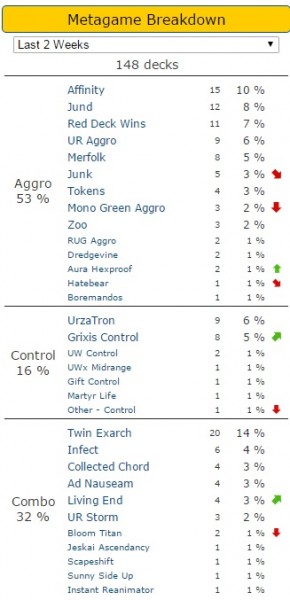
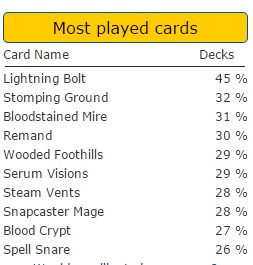
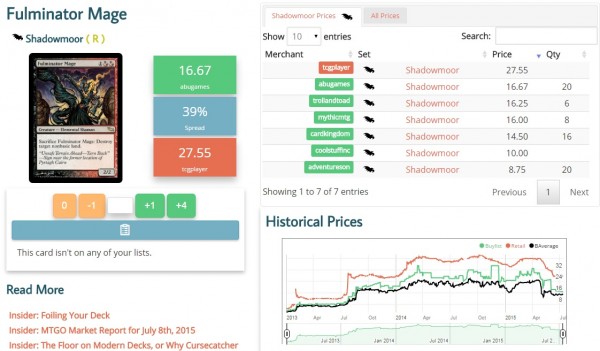
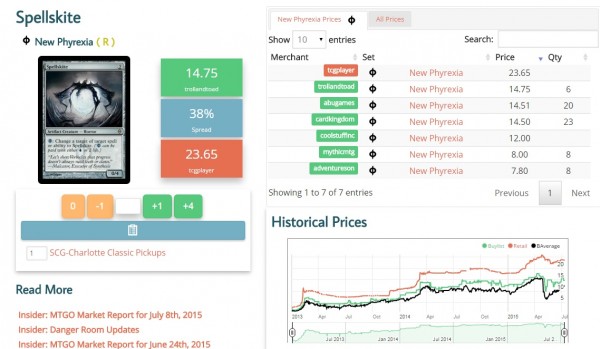
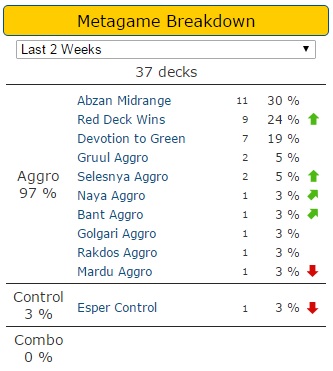
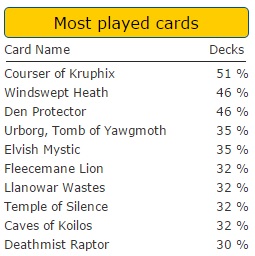
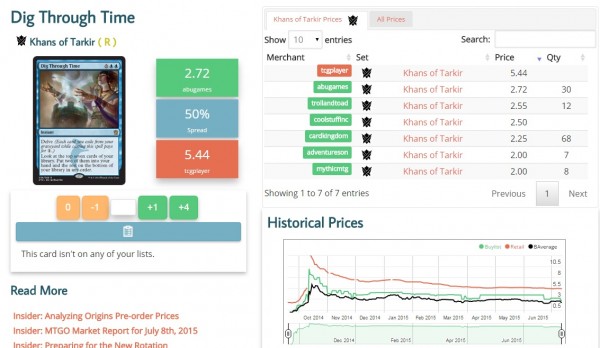


I always see people say something that feels like has become common knowledge: “people play an inordinate amount of mono red online even though it’s not a real deck because it is cheap to build.” (And they extend this logic to any deck that is deemed not particularly competitive but cheap to build online.)
I am quite opposed to this view. I think that people that play MTGO are if anything much more competitive in their deck selection, and I think so for a few reasons. First, it is easier to switch decks online, meaning that players can shift according to the metagame in a faster time frame. Second, the average player is much better online, and since you can play tournaments multiple times a day, a losing strategy loses you a lot more money in a shorter period of time.
Let’s go back to mono red. Do people not realize how good this deck is? Are people so quick to forget that it won the last Pro Tour? Sure, it’s a linear deck that will lose to a bunch of sideboarded arashin clerics and drown in sorrows, but that doesn’t make it a bad deck.
The same goes for mono red in Modern. It put 2 copies in the top 8 of the last Modern Pro Tour.
I think it’s time for people to finally realize that mono red is a tier one deck in both Modern and Standard, and the reason so many people play it online is because it’s so freaking good! (Also people have strong emotional, subjective feelings about mono red because they feel it is an “unskilled” deck.)
My comments were not aimed to call RDW an “unskilled deck”, they were aimed at emphasizing the fact that cost IS a factor in any metagame and that the online vs paper metagame is different. And while I agree that there is definitely potential for “more financial loss” online playing a bad deck, there are still plenty of people who use MTGO for testing purposes and playing a very proactive deck like RDW’s is a very good strategy to beating decks that are currently in development/testing. The same testers online are more likely to bring a “finished product” to a larger event instead of using a GP or SCG-Open as a testing ground.
I know that your comments were not aimed to call it unskilled. I am not even targeting your article as much as I am targeting this “prevailing wisdom” about the MTGO metagame. I will continue to contend that the MTGO metagame is much closer to the abstract version of a completely competitive metagame than for example an SCG Open. Therefore I think you can rightly put a lot of weight on online results.
I don’t have a scientific way of proving this theory, but it is based off of my experience playing thousands of games both online and offline.
For example: one guy was destroying the dailies online by using Amulet Bloom, a deck often discounted by the offline crowed. Then lo and behold 2 of the very few people playing it at the Pro Tour reached top 16 with the deck and people finally figured out it was a powerhouse.
I think it is silly to say something like “RDW is a very good strategy for beating decks that are in development/testing because it is proactive.”
RDW is a good strategy for beating deck in development/testing because it is a good deck period. Any good deck whether it is control, aggro, or midrange will destroy a deck in development/testing based off its power level, not based off its aggressiveness.
I’m not even particularly partial to RDW in Standard or Modern. I have played a lot more Abzan Control and an equal amount of abzan aggro, esper dragons, RW, and jeskai tokens in Standard.
I am trying to make a case against what I feel are baseless statements about the online metagame positing that they are overly influenced by cost-considerations or strategies that only work online. Again, this seems to be a prevailing wisdom and my comment is absolutely not directed at you personally or your article in particular.